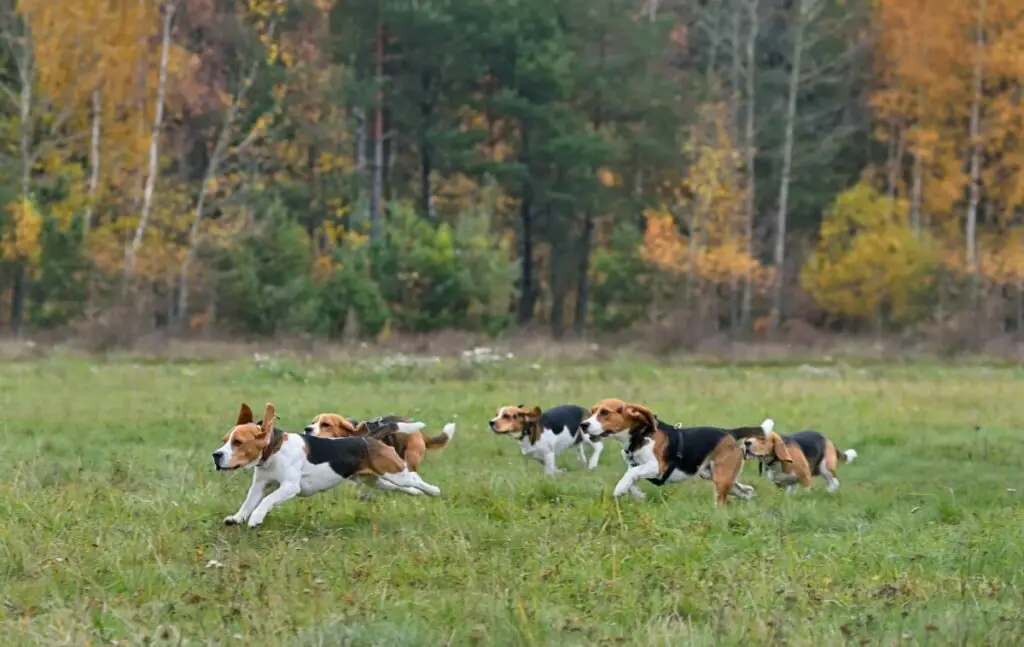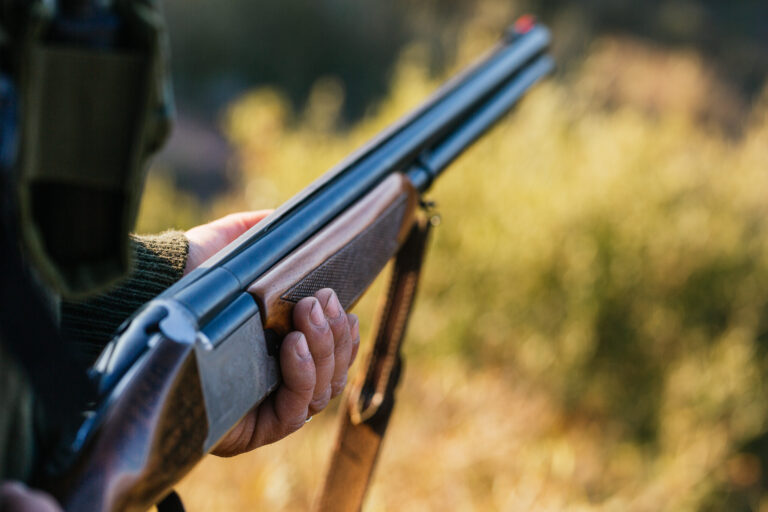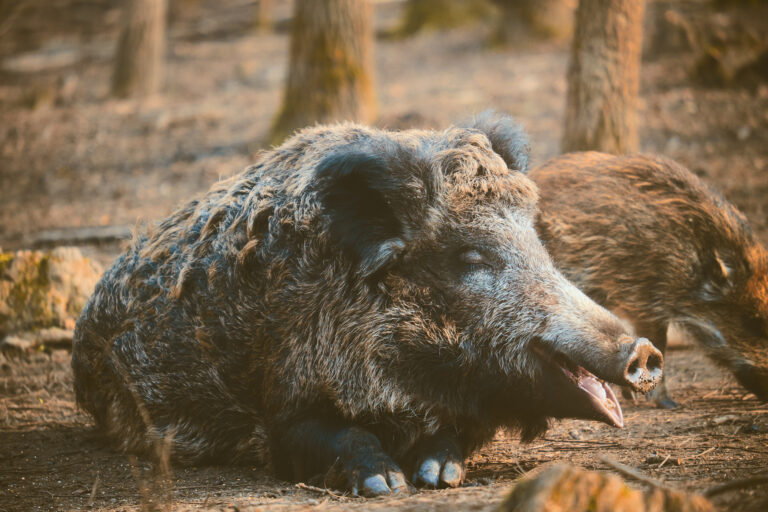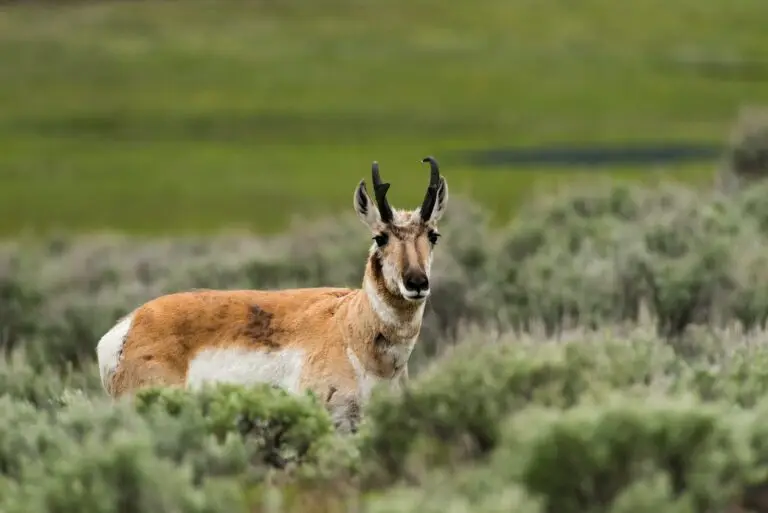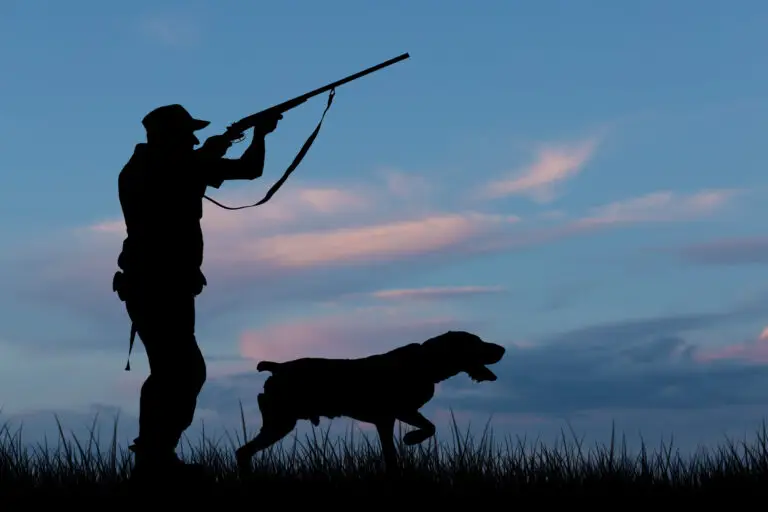Looking for a quality hunting dog that doesn’t take up too much space? You’re in luck! Over the years, numerous breeders and cultures have shared that very same sentiment, and meticulously bred these five dogs to fit that category.
Even better, we’ve compiled a comprehensive overview of the top 5 premier small hunting dogs for you. We’ve covered each dog’s history, breeding background, strengths, weaknesses, and ideal hunting prey right here!
Depending on what you like to hunt, one of these wonderful buddies might just be your next best friend.
In no particular order, let’s get into it!
#1 Beagle – The Tracker
First on our list, we have the famous Beagle!
One of the most distinguishable hunting dogs out there, the beagle is thought to have originally originated from the Romans way back in the day. In those ages, the beagle’s ancestors would hunt small game such as squirrels and hares.
The modern Beagle, however, was developed in the UK from various small hound breeds where the ultimate goal was to create a breed of dog with a keen sense of smell, stamina, and determination.
If you’ve ever caught an episode of Downton Abbey (it’s my guilty pleasure, don’t judge) you’ll often see the aristocratic Victorian upper-class hunt with a whole horde of beagles; that is because they’re primarily pack animals.
That doesn’t mean they’re not suited alone! But if you’re getting one, I would definitely make sure it has a buddy in the house.
The beagle has a sense of smell only second to the bloodhound, and it is precisely because of this incredible nose they’re so excellent for hunting; they’re gonna track down the prey in no time.
Pros
- Excellent nose that allows them to track down prey quickly
- Incredible stamina despite their size, so they can keep hunting for long extended periods
- Beagles have a distinct bark when they’re on the scent, which immediately calls the hunter back to the dog even when it’s running out of sight.
- Overall friendly, determined, and eager-to-please behavior makes the training process fairly straightforward
Cons
- Determination can unfortunately sometimes translate into stubbornness, which means that once they’re on the scent it is going to be incredibly difficult to recall them or get their attention away from the prey
- They’re a little… dumb, respectfully. Or let’s say “single-minded” — once they’re on the scent they become completely oblivious to their surroundings, which has the potential to lead them or you into danger
- Their distinct bark that happens when on the scent renders them virtually useless for any hunting that requires more than an average amount of stealth
- Not great for any form of waterfowl or upland bird hunting
Best for rabbit, fox, coyote & small game
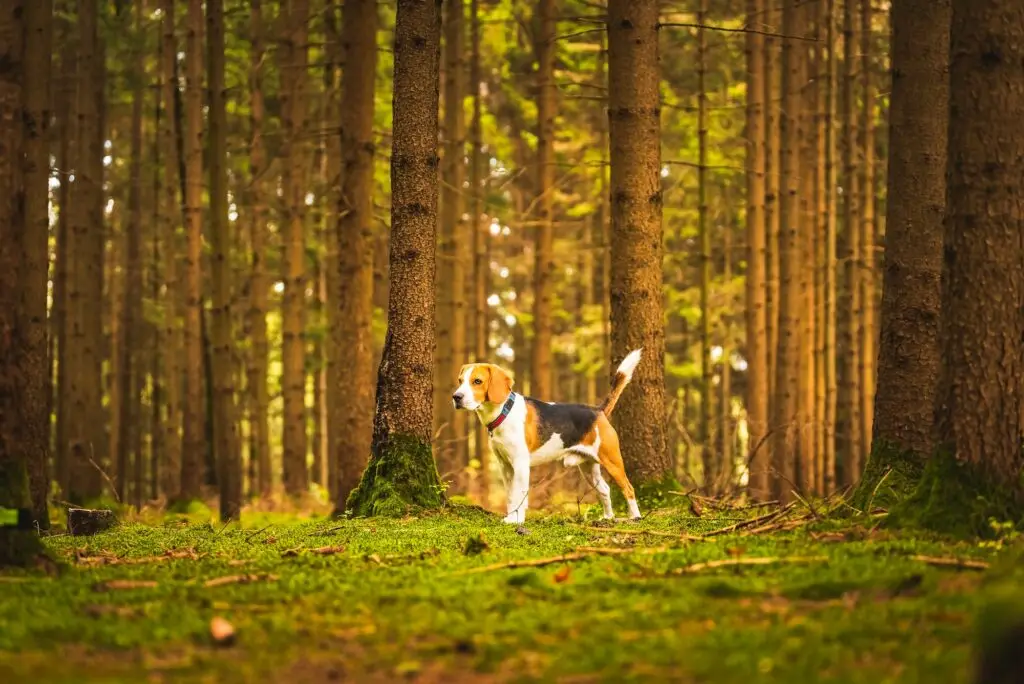
#2 Cocker Spaniel – The Flusher
Next up is the charming Cocker Spaniel!
Their origins are traced back to Spain, with the word “spaniel” essentially translating to “Spanish dog”. They were then introduced to the UK and developed further as hunting dogs there in and around the 19th century.
Back in the 18th century, they would hunt woodcocks, which is where it got its name from. They’ve been excellent bird-hunting companions for several hundred years now because of their versatility.
Their primary role tends to be to flush out game such as pheasants, grouse, and partridge from dense brush. Because of their size and agility, they can move incredibly swiftly through the underbrush to both locate and scare off birds.
Pros
- Incredible agility because of their size and physique
- Doubles up as retrievers, as not only do they naturally retrieve game for you – but their soft and gentle mouths also ensure the game is returned undamaged
- They’re friendly and excited and will do anything to make you happy, which makes training relatively easy
- Cocker Spaniels are excellent swimmers, so they can retrieve game from the water
Cons
- Their energy levels are through the roof, which means that if its not channeled properly will become a real challenge in non-hunting home environments
- They’re very noise-sensitive, which is an issue when half of hunting includes firing off a really loud gun. You’ll have to slowly introduce them to gunshots in a carefully conditioned manner.
- Their coats are beautiful and silky, but that also means they require regular grooming to prevent mats and tangles. The coat also tends to pick up burrs, seeds, and twigs during the hunt which makes clean-up after hunting and camping kind of a pain in the butt.
- Cocker spaniels are unfortunately super prone to health concerns like ear infections and hip dysplasia, so regular check-ups are essential.
Best for waterfowl, woodcock, pheasant, partridge, grouse, quail & snipe
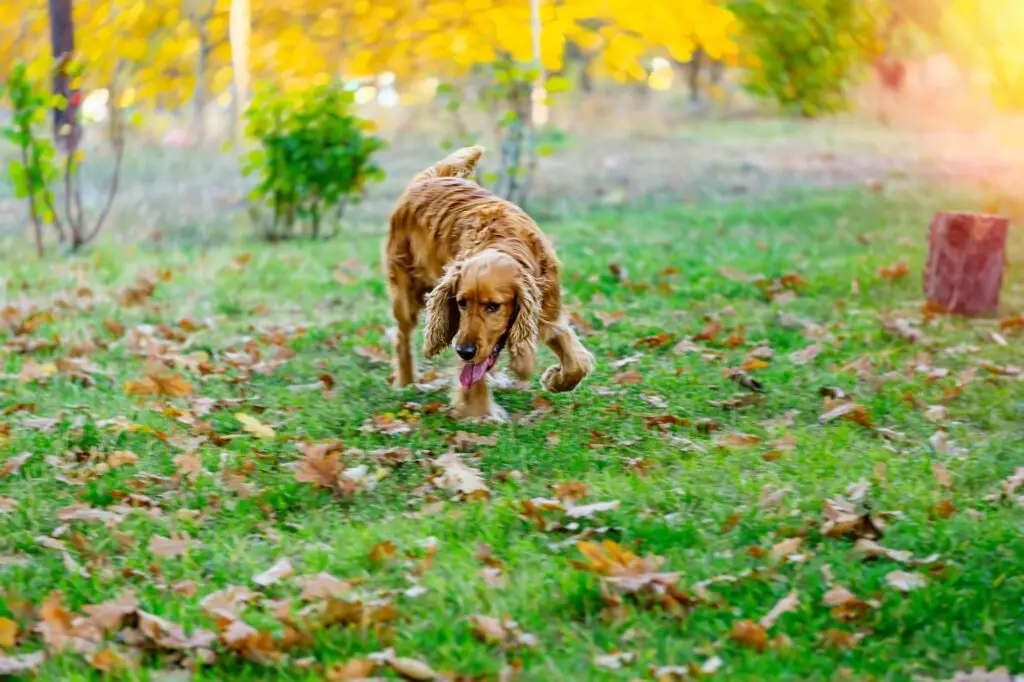
#3 Dachshund – The Burrower
Next up we have the Dachshund, often referred to as the “wiener dog”
Literally translated it means “badger dog”, so that should give you an idea of their primary hunting role. Originally developed in Germany hundreds of years ago, their long body and short legs were expertly developed to dig and burrow into badger dens.
The most impressive part of the dachshund is their tenacity; as they were bred to take on badgers which are notoriously known as being fierce fighters.
Pros
- Dachshunds are incredibly persistent and determined and will track down their game with intense focus
- Despite their small size, they have a deep and loud bark which makes them easy to locate when hunting (which was especially useful back when their hunting was primarily done underground)
- Although I keep blabbering on about badgers, the dachshund is super versatile and has proven itself as a wonderful hunting companion for pretty much all other small games as well.
Cons
- Dachshunds are notoriously stubborn. They’re a little too smart for their own good, very independent thinkers, and as a result, can be tricky and frustrating to train at times.
- Because of their long spine, they’re susceptible to IVDD (intervertebral disk disease), which can make them physically vulnerable.
- If they’re not socialized really well, their strong prey drive tends to make them very aggressive towards other dogs and smaller animals.
- They’re sensitive to sound, so you have to ensure proper introduction and conditioning to gunshots before you take them out in the wild.
Best for hunting badgers, rabbits, foxes, hares, and any general burrow-dwelling animals
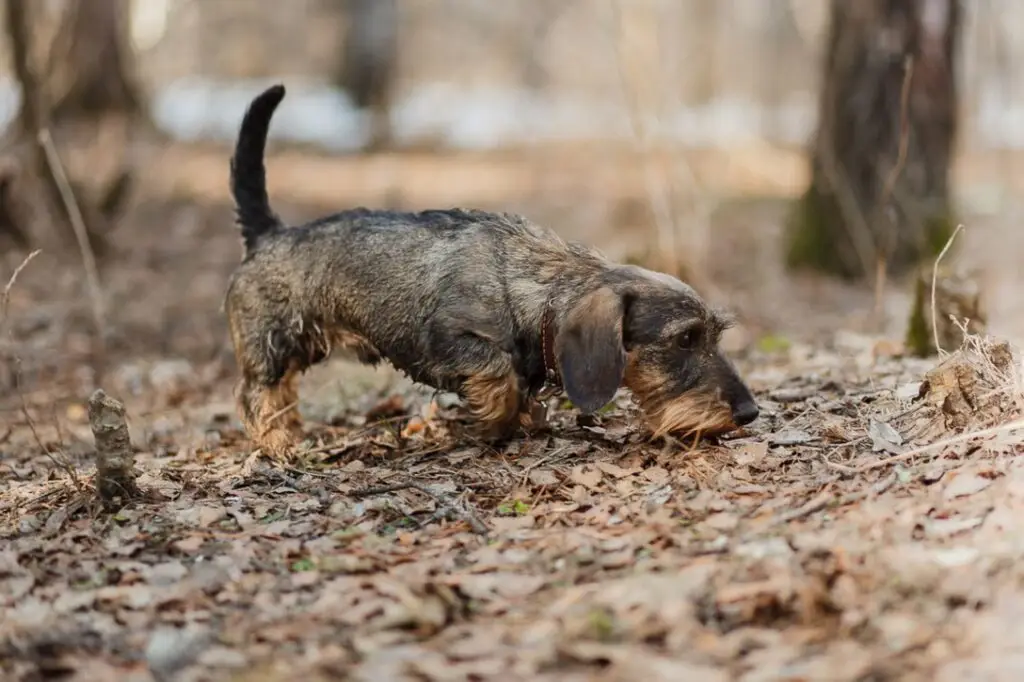
#4 Brittany – The Pointer
Next, we got the “biggest” dog on our list, the beautiful Brittany.
Named up after the Brittany region in northwest France where it originated, the breed’s ancestry is all over the place; with a mix of both local Spaniels and English pointer breeds.
The Brittany was originally bred and trained as a bird dog, with its history carefully intertwined with upland game bird hunting. It’s a pointing breed, meaning it will point toward the game to alert the hunter once it’s tracked.
They flash as excellent bird-hunting dogs, as they’re not just wonderful trackers and pointers, but are happy to carefully retrieve game as well. Because of their size and nose they navigate terrain with ease and will rarely see any issues in the wild.
Pros
- Brittany’s have a lot of energy and stamina which makes them excellent endurance trackers for extended hunts
- They double up as both pointers and retrievers, which makes them exceptionally great and versatile for upland game bird hunting
- Their enthusiasm and passion for hunting make them joyous to work with and easy to train
Cons
- Brittany’s are known for their extremely high energy levels, which can become… destructive to say the least, if not given the right outlets
- Their coat is mostly low-maintenance, but after a day in the brushes, it tends to get tangled up in all sorts of debris and can easily start to mat.
- They’re super sensitive and dramatic. Not husky-level but… It’s up there.
- Brittany’s love to roam, especially if they catch a scent – so you have to spend a lot of time on recall training.
Best for hunting upland birds such as pheasant, partridge, grouse & woodcock.
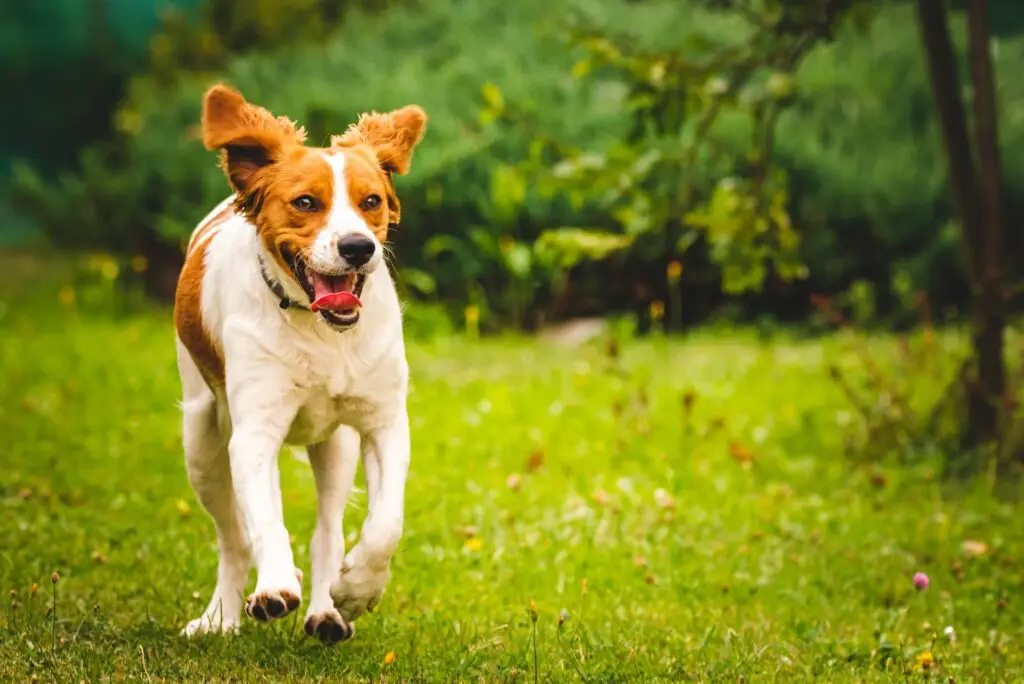
#5 Jack Russel Terrier – The Digger
Last but not least we have the adorable Jack Russel Terrier.
Originally developed in 19th century England by the Reverend John Russell (I also have no clue who that is don’t worry) who wanted a terrier that could help him hunt foxes without actually harming them.
The idea was that it would be small enough to fit into foxholes, but also brave enough to face them underground. The white coat was purposefully bred to be easily distinguishable from the game during hunts.
“Terrier” actually means “earth” in Latin, as they excel at both burrowing and digging (so just a warning if you happen to own a really nice currently hole-free garden).
Pros
- Jack Russel Terriers are fearless, brave, and ready to take on any challenge regardless of size.
- Despite their small size, JRTs are impressively fast and have a surprising amount of stamina which serves really well for the hunt
- Very little training gains great results as they have a very high prey drive
- Nimbleness, size, and agility allow them to navigate challenging terrain and tight spaces with ease.
Cons
- Although mostly positive, their high energy easily becomes a challenge in everyday life. They need lots of walks, playtime, and attention to not start exhibiting behavioral problems.
- You have to spend a lot of time socializing Jack Russel Terriers because if you don’t they’re gonna be overtly aggressive towards all other pets. If you have a cat or rodents, JRTs might not be the way to go.
Best for hunting foxes, rabbits, rats, general vermin, and your cats
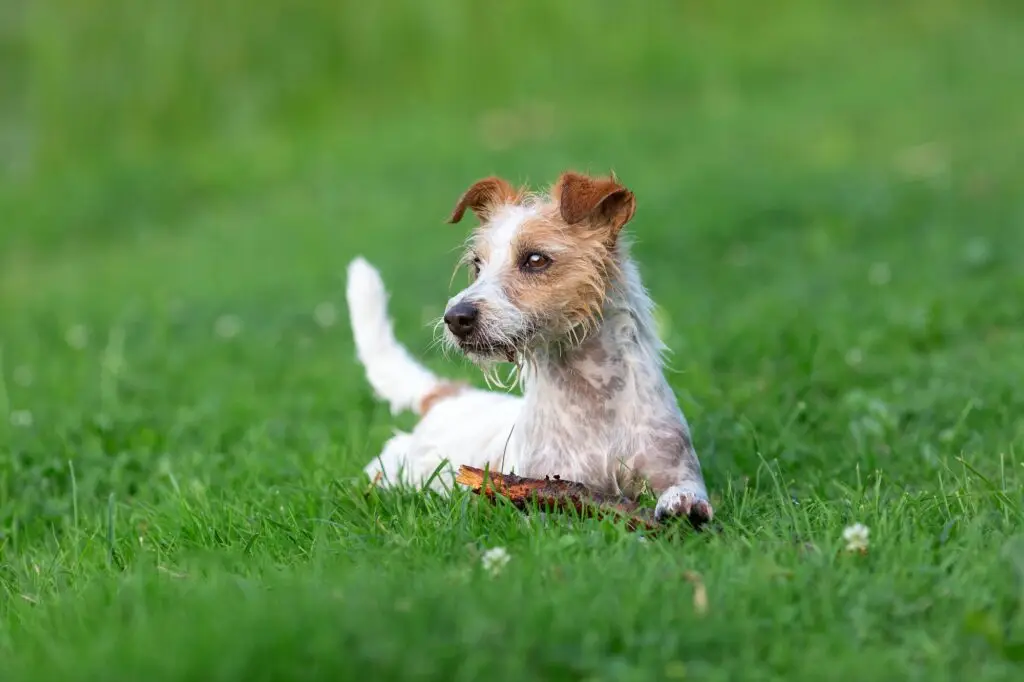
And there you have it! The 5 best small hunting dogs on the market
As you can see, if you’re looking for a smaller hunting dog, you’ve got lots of options.
Each breed comes with its unique strengths and weaknesses, but regardless of what you decide to go with, it’s important to understand these trade-offs to find the right hunting companion that will best serve your needs, while also ensuring a positive and enriching life for your buddy.
Also, keep in mind that a vast majority of the time your new best friend is going to be at home, with you and your family, and not in the wild. Make sure that you also do research about how each dog behaves in the home life as well, and discuss their personality with the breeder.
That’s all I got for you!
If you’re looking for some great hunting dog names, check out our article on the best names right here.
If you’re looking for the best duck hunting dogs out there you can read all about them here.
For any other hunting-related content, you can check out our extensive library right here.
Happy hunting!
